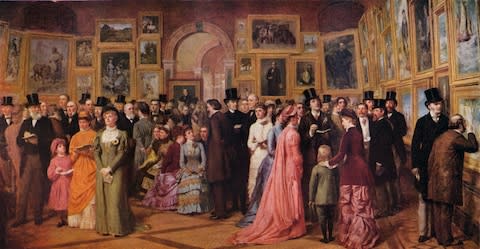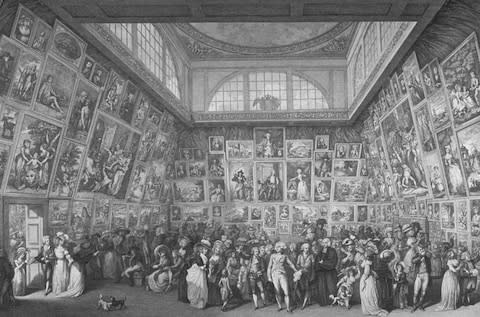The Royal Academy at 250: Inside the £56 million makeover for art's most 'establishment' yet eccentric institution

People think it’s all men in three-piece tweed suits,’ says Christopher Le Brun, the painter and sculptor who is president of the Royal Academy of Arts, which this year celebrates its 250th anniversary. ‘But this place is full of emotion. Lashings of it.’
At least three times a year, all academicians (artists and architects elected as members of the Academy) gather to approve changes to RA laws, elect new academicians and consider matters relating to members’ affairs, presided over by Le Brun. The result is often a bun fight.
‘They’re very strong-minded, highly intelligent but not necessarily very organisationally orientated,’ says Charles Saumarez Smith CBE, secretary and chief executive. Leaning back into a sofa in the Academy’s Grimshaw Library, he recalls his first General Assembly in 2007 when he was approached by the abstract painter John Hoyland, a forthright Yorkshireman.
‘It was fairly obvious he’d been in the pub. And he looked at me with such burning hatred. I thought, “Well, hang on a minute, what have I done to deserve this?”’ Some of the artists, Saumarez Smith says, will always see him as ‘a suit’.

Spats and feuds have been part of the fabric of the RA since its foundation. The caricaturist Thomas Rowlandson was almost kicked out for firing a pea-shooter at a female model in the 1770s, and later JMW Turner and John Constable were the Bette Davis and Joan Crawford of the institution, sparring constantly. In the late 1990s, Sir Norman Rosenthal, who was in charge of exhibitions, is said to have thrown a telephone at the Academy’s then secretary David Gordon (allegedly, guards had to break up the scuffle).
Now there are 79 members, compared with the original 36 when founding president Sir Joshua Reynolds was at the helm, so the role of president is more complex than ever, and as its 26th, Le Brun is part peacekeeper and part ambassador.
‘I do the job for three days, I paint for three days. And on the seventh day I become a father, grandfather, husband and mow the lawn,’ he laughs.

Standing in his Piccadilly office, Le Brun has a neat granite beard, grey suit and the air of an Edwardian lawyer, but in making the president’s office his own he has shown his artistic hand. When his predecessor, the architect Sir Nicholas Grimshaw, occupied the office, it was full of filing cabinets. Today, they have gone and the room is dominated by Painting as Sunrise, Le Brun’s monumental abstract canvas of scarlet, turquoise and grey oils.
‘Although we say we’re a centre of debate, frankly debate isn’t enormously enjoyable,’ he says. He discussed this with the Archbishop of Canterbury when they met at a private dinner party hosted by the Queen at Windsor Castle. ‘Because we’re about the same age, I had the cheek to say to him, “How you getting on?” And he said, “I’m the only person in the Church of England who doesn’t get his own way.” I thought, “Welcome to the club.”’
Le Brun’s most recent project has been his greatest challenge: overseeing a £56 million redevelopment of the Royal Academy, which will be unveiled on 19 May to mark its anniversary. The project has taken three years to complete and includes a linking bridge, made from industrial concrete and glass, that connects Burlington House, an 18th-century Palladian mansion on Piccadilly, and 6 Burlington Gardens, a Grade-II listed building in Mayfair, both part of the RA’s two-acre ‘campus’, which also includes the RA Schools. The new development also includes six new galleries and two new studios, and will increase the Academy’s space by 70 per cent.
The ‘New RA’ as the project is known, was designed by Sir David Chipperfield, who was elected to the institution in 2007. As both architect and client, he was one of the few people who could navigate the choppy waters of such a project. ‘For this whole project to work, the Schools had to accept that their quiet, peaceful existence at the back of the house would be exposed and invaded,’ he says. ‘We unlocked it by territorial negotiation, ground swapping and horse trading.’

Talking on the phone on the way to his office in Milan, Chipperfield adds, ‘This isn’t really a project about a big vision, it’s eight small visions that when you put them together create the big vision… Selling that to artists and sculptors and fellow academicians wasn’t complicated. They’re a sophisticated bunch.’
The Royal Academy was formed in 1768 when a group of 22 artists and architects successfully sought the ‘patronage and protection’ of King George III. Its subsequent members – always elected by sitting academicians – form a roll call of masters, including Gainsborough, Turner, Constable, Leighton, Zoffany, Millais, Soane, Kauffman, Knight, Frink, Hockney and Gilbert & George (elected last year as a single member).
‘It’s so “the establishment” that it’s not the establishment,’ says Tracey Emin, a member since 2007 and for two years its professor of drawing. ‘It’s still draconian, it’s still crazy. It’s such an eclectic mix of people.’

Academicians donate a ‘diploma work’ on election and, combined with bequests from members, the resulting collection is one of the most eclectic of any gallery in the country, mixing Renaissance, Pre-Raphaelite and modern masterpieces, with highlights including Michelangelo’s Taddei Tondo, the only marble by the artist in Britain.
Some of the works have been kept in storage, but after the redevelopment many will be shown in a dedicated Royal Academy Collection Gallery, which opens with Le Brun’s personal selection, including a 16th- century copy of Leonardo da Vinci’s The Last Supper.
In addition, more than 10,000 works from the collection have been digitised and made available online in time for the anniversary. Meanwhile, the Summer Exhibition – an annual highlight of the RA’s calendar, where works by the likes of Thomas Heatherwick, Grayson Perry and Antony Gormley are shown alongside those by hobbyist artists – will now expand to also fill one of the new galleries.
The redevelopment may also go some way towards shaking off the RA’s musty image and returning the institution to its purpose of being not just an exhibition venue but a seat of learning. The RA Schools is the oldest and the only free art school in Britain (last year, 688 applicants fought for 16 places on its postgraduate diploma), and its redevelopment includes a new 250-seat lecture theatre, in which Chipperfield will present the first public lecture on his design for the ‘New RA’.
Do you mean am I an egotistical maniac? No. It’s a different time. I think Norman [Rosenthal] was a genius; I think Norman was also, on occasion, difficult
Tim Marlow
When the redevelopment was announced in 2015, Chipperfield joked, ‘we’re sort of knocking a hole in the wall and making a little bridge’. But it is so much more.
I visited the day before the Queen received a preview as the Academy’s present patron – the New RA was buoyantly bright. At the north-east corner of Burlington Gardens in the new lecture theatre, Chipperfield has turned two floors into one cavernous double-height auditorium with skylights. As he puts it, ‘Why not have daylight?’ The bespoke leather seats have yet to arrive.
In the new Gabrielle Jungels-Winkler Galleries, the exhibition space has south-facing windows and top lighting from glass panels in the exposed arched roof. Meanwhile, the contemporary passage, the Weston Bridge, has a floor-to-ceiling pane of reinforced glass and is bookended by two further galleries, one to present work by present academicians, the other work by RA students.
Even the once-gloomy vaults of Burlington House will be home to a final illumination: the corridor will be lined with the spot-lit, ghostly shapes of anatomical and sculptural plaster casts. It is a sequence of galleries and channels shaped by light. It feels unified.

This is quite an achievement considering that Chipperfield describes the RA as ‘the Naples of the museum world’ – referring to its chaotic atmosphere and cacophony of voices. He recalls the hullabaloo over the new toilets on the Burlington House side, which opened six months before everything else. ‘I’ve never had so many comments about bathrooms before,’ he laughs.
Fundraising for the project was led by Le Brun, Saumarez Smith, Sir Richard Carew-Pole and Lord Davies of Abersoch CBE, chairman of the Royal Academy Development Trust, with virtually no Government backing. As Saumarez Smith points out, ‘Because we’re not funded by Government, we don’t have to pay attention to Government’.
He won a £12.7 million grant from the National Lottery, which brought the backing of trusts and foundations and in turn the interest of private individuals. Several of the new galleries are named after benefactors, including the educational philanthropist Gabrielle Jungels-Winkler and Hong Kong billionaires Ronald and Rita McAulay.
So what does it cost to have a gallery named after you? ‘If you are a prospective donor I’m happy to have the conversation,’ Saumarez Smith says tactfully. Artistic director Tim Marlow adds, ‘It’s not chicken feed.’

In recent years, artists such as Ai Weiwei, Anish Kapoor and Anselm Kiefer have drawn a younger crowd to the Academy. Marlow says, ‘Some 25,000 schoolchildren came on our official programme to Ai Weiwei. If you put on shows of a certain quality and you build up a momentum, different social groups and age groups can be attracted to come and make a leap of faith.’
In 2020 the Academy will present new and old works by the Serbian performance artist, Marina Abramovic, the RA’s first monographic show by a woman in its main galleries – she has announced she plans to shock herself with one million volts at the event. Marlow adds, ‘If you don’t evolve and attract different audiences you ossify as an organisation.’
Blockbuster exhibitions at the RA were largely the innovation of Sir Norman Rosenthal, exhibitions secretary from 1977 to 2008 (his 1997 Sensation show launched the Young British Artists group, and controversially included Damien Hirst’s shark-in-formaldehyde The Physical Impossibility of Death in the Mind of Someone Living and Marcus Harvey’s Myra, a portrayal of Moors murderer Hindley).
Critics of Rosenthal claimed that while his tenure was dynamic it was also divisive among academicians, and that he imposed his own taste on the Academy. Does Marlow tread more carefully? ‘Do you mean am I an egotistical maniac? No,’ he says. ‘It’s a different time. I think Norman was a genius; I think Norman was also, on occasion, difficult.’
Another criticism often levelled at the Academy is that it has been an old boys’ club – there has never been a woman president. Rebecca Salter, an expert in Japanese woodblock printing, is Keeper of the Royal Academy and only the second woman to hold the position. ‘In my view, it is nowhere near as toxic as some male environments. I think it probably was, not that long ago,’ she says. ‘If you’re a woman of my age [she is in her 60s] you’ve spent the majority of your life in male environments.’
She points out that there are women in several senior business roles. ‘It’s going through a period of change but I think, like everywhere, we’ve got our in-house misogynist.’ And Emin jokes, ‘I like being an academician. I haven’t exactly got the beard yet, but it’s coming slowly.’

However, the consensus remains: times are changing at the academy. ‘Originally, the Red Collars were the models,’ laughs Salter. ‘They’re our in-house security guys – they’ve got red collars on their uniform. It was part of the job description: they would model in the life-drawing room of the Schools.
'I don’t know how many applicants you’d get now – one would like to know what it was like trying to enforce some kind of discipline when you’d had your kit off an hour earlier.’
Even so, the RA remains a citadel in an art world shaped by the vested interests of public galleries, dealers and major private collectors. ‘The artist is rather homeless within those organisations,’ Le Brun says.
‘The point of the Academy being set up was to establish the independent professional status of the artist. And that’s just as vital now as it was in 1768.’
The New Royal Academy of Arts opens on 19 May 2018

